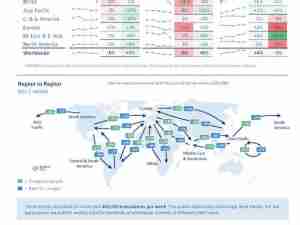Los Angeles World Airports (LAWA) is hot on the trail for Asian business. Thanks to its West Coast location in one of the strongest markets in the United States, LAWA's airport system is already tops for trans-Pacific traffic, excluding Anchorage which serves primarily as a fuel stop.
Airlines that currently provide cargo service of one form or another between LAX and Asian destinations are: Air China, Air New Zealand, American Airlines, Asiana, Atlas Air Cathay Pacific, FedEx, China Airlines, China Cargo Airlines, China Eastern, EVA Airways, Evergreen, JAL, Korean, Malaysian Airline System, NCA, Northwest, Phillipine Airlines, Polar, Qantas, Singapore Airlines, Thai Airways, United Airlines, Varig, and World Airways.
The following airlines have recently announced new direct cargo service between LAX and Asian destinations: Dragonair (Hong Kong); Transmile (Kuala Lumpur); and Air Macau (Macau).
While many US airports derive the bulk of their international cargo business with Europe, LAWA, with its Los Angeles International Airport (LAX) and LA/Ontario International Airport (ONT), cargo volumes are predominately Asia-related. Volumes should continue to escalate, a challenge and an opportunity LAWA officials continually address.
"LAWA plans to accommodate the expected growth in air cargo traffic between North America and Chinese markets during the next several decades through the development of a better balance between its two major international airports, LAX and ONT," comments Mark Thorpe, LAWA director of Air Service Marketing.
LAWA finds itself in an enviable position given the fact that trans-Atlantic gateways have languished since the late 1990s as Europe has provided nowhere near the stimulus that Asia has to the West Coast.
"Big international gateways in the Eastern United States have only exhibited something that 'appears' to be growth, but is actually only a recovery of ground previously lost," comments Michael Webber, LAWA's air cargo consultant. "By comparison, the trans-Pacific gateways have tended toward real (Asia-induced) growth. As everyone knows, Asia was far less affected by the economic consequences of our 9/11. Even the impact of SARS was fairly limited over the long-haul, and the US economic melt-down was somewhat of a non-factor as well. Despite the weakened American dollar, et al, we keep importing from Asia."
Webber points out that cargo volumes at ONT almost immediately recovered as UPS actually prospered post-9/11, as did FedEx at Oakland International Airport (OAK).
"UPS fed much of that traffic through their regional hubs," he says. "In fact, ONT is one of the few US airports that could count as both a trans-Pacific gateway and a regional integrator hub, albeit for the same carrier."
Both LAX and ONT are currently among the fifteen busiest cargo airports in North America, as are OAK and San Francisco International (SFO). But unlike LAX and ONT, SFO and OAK are not part of a single management operating system.
"That difference is far more than semantic," Webber remarks. "ONT derives incomparable benefits from sharing management with an airport that has literally 'seen it all.' As you well know, Asian operators do tend to value long-term relationships , and a move to ONT will leave intact decades of operating history. Moreover, LAWA is preparing an incentives package for operators who will move some of their freighter operations to ONT."
With LAX already near capacity, LAWA plans to accommodate traffic growth in the Pacific region by developing new cargo facilities at ONT, beginning with the soon-to-be-built 1,000,000-square foot Aeroterm facility. Aeroterm is planning to break ground on this building during 2006, and complete its facility in three tranches of approximately 300,000 square feet each. LAWA is taking the approach of ONT being LAX's "sister international cargo gateway."
"What is perhaps distinctive about that initiative is that LAWA can develop another million square feet(and potentially






